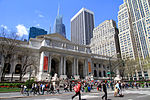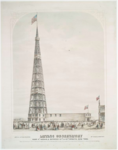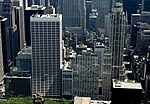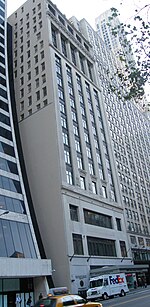Croton Distributing Reservoir

The Croton Distributing Reservoir, also known as the Murray Hill Reservoir, was an above-ground reservoir at 42nd Street and Fifth Avenue in the New York City borough of Manhattan. Covering 4-acre (16,000 m2) and holding 20 million US gallons (76,000 m3), it supplied the city with drinking water during the 19th century. Its massive 50-foot-high (15 m) granite walls, which presented a vaguely Egyptian-style facade, were 25 feet (7.6 m) thick. Atop the walls was a public promenade offering panoramic views; Edgar Allan Poe enjoyed walking there.When established, the Croton Aqueduct was New York City's foremost water source. Construction began in May 1837 and filling began July 4, 1842 amidst great fanfare. Prior to construction of the aqueduct, water was obtained from cisterns, wells and barrels from rain. The aqueduct and reservoir obtained their names from the water's source, a series of mostly underground conduits that would bring water from the Croton River in northern Westchester County to New York City's spigots.
Excerpt from the Wikipedia article Croton Distributing Reservoir (License: CC BY-SA 3.0, Authors, Images).Croton Distributing Reservoir
5th Avenue, New York Manhattan
Geographical coordinates (GPS) Address Website Nearby Places Show on map
Geographical coordinates (GPS)
| Latitude | Longitude |
|---|---|
| N 40.753333333333 ° | E -73.9825 ° |
Address
New York Public Library (The Humanities And Social Sciences Library;Stephen A. Schwarzman Building)
5th Avenue 476
10018 New York, Manhattan
New York, United States
Open on Google Maps











